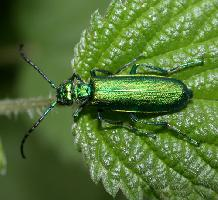
Súlyok és méretek
| Hossz | 12-tól 20-ig mm |
|---|
Állatleírás
The Spanish fly (Lytta vesicatoria) is a species of blister beetle belonging to the family Meloidae. Despite its common name, it is not a fly, but a beetle, and its fame or infamy comes from its historical use in traditional medicine as an aphrodisiac. The beetle is native to southern Europe, but its range extends to Central Asia and Siberia, demonstrating its adaptability to various climates.Adult Spanish flies have a striking appearance, measuring between 15 to 22 millimeters in length. They possess a metallic, shimmering green coloration that can vary to include shades of gold, copper, or even blue depending on the light. This iridescence not only makes them visually distinctive but also serves as a warning coloration to potential predators about their toxicity. They have elongated bodies, soft elytra (wing covers), and relatively long legs, which are characteristic of the Meloidae family.
The life cycle of the Spanish fly is both fascinating and complex, involving several stages of development known as hypermetamorphosis. The female lays her eggs on plants that are in proximity to the ground. Once hatched, the highly mobile first-instar larvae, known as triungulins, actively seek out flower buds or climb onto flowers to hitch a ride on solitary bees. They then enter the bee's nest where they feed on bee larvae and the bees' provisions of pollen and nectar, undergoing several larval stages before pupating and emerging as adults the following summer.
The notorious reputation of the Spanish fly stems from the compound cantharidin, which the beetles produce as a defense mechanism. Cantharidin is a potent blistering agent that causes severe chemical burns upon contact with skin and mucous membranes. Historically, it was harvested by drying and crushing the beetles into a powder, which was then ingested or applied topically as an aphrodisiac. However, its use is highly dangerous, as cantharidin is toxic and can lead to severe gastrointestinal and urinary tract irritation, renal failure, and even death if consumed in sufficient quantities.
Today, the use of Spanish fly as an aphrodisiac is largely discouraged and regulated due to its toxic properties and the ethical considerations surrounding the harvesting of the beetles. Nevertheless, the Spanish fly remains a subject of historical interest and a symbol of the lengths to which humans will go in pursuit of love and desire.
Conservation-wise, Lytta vesicatoria does not currently face significant threats that would warrant concern. However, like many species, it could be affected by habitat loss, pollution, and climate change. Continued monitoring of its populations and habitats is essential to ensure that this intriguing but dangerous beetle remains a part of our natural world.
Új állatfotók
Top 10 állat
- Diana monkey (Cercopithecus diana)
- Dolphin gull (Leucophaeus scoresbii)
- Moustached guenon (Cercopithecus cephus)
- Galápagos tortoise (Geochelone nigra complex)
- Stone loach (Barbatula barbatula)
- Japanese spider crab (Macrocheira kaempferi)
- Colossal squid (Mesonychoteuthis hamiltoni)
- Common house mosquito (Culex pipiens)
- Common reed warbler (Acrocephalus scirpaceus)
- Sea urchins (Echinoidea)